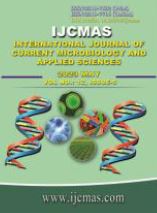


 National Academy of Agricultural Sciences (NAAS)
National Academy of Agricultural Sciences (NAAS)

|
PRINT ISSN : 2319-7692
Online ISSN : 2319-7706 Issues : 12 per year Publisher : Excellent Publishers Email : editorijcmas@gmail.com / submit@ijcmas.com Editor-in-chief: Dr.M.Prakash Index Copernicus ICV 2018: 95.39 NAAS RATING 2020: 5.38 |
Quorum Sensing is the regulation of gene expression in response to fluctuations in cell population density. Quorum-sensing bacteria produce and release chemical signaling molecules called Self-Conductors whose concentration increases with cell density. The detection of the minimum threshold excitatory concentration of the autoantibody leads to a change in gene expression. Gram-positive and Gram-negative bacteria use quorum-sensing communication circuits to regulate a wide range of physiological activities. These processes include symbiosis, virulence, competence, conjugation, antibiotic production, motility, sporulation, and biofilm formation. In general, gram-negative bacteria use acylated homoserine lactone as an Auto-Inducer and gram-positive bacteria use treated oligo-peptides for communication. Recent advances in this field indicate that cell-to-cell communication via self-conductors occurs both within and between bacterial species. In addition, growing evidence suggests that bacterial autoinducers elicit specific responses from host organisms. Although the nature of the chemical signals, signal transduction mechanisms, and target genes controlled by the bacterial quorum sensing system are different, in all cases the ability to communicate with each other allows bacteria to coordinate gene expression, and thus behavior, of entire communities. Presumably, this process gives the bacteria some of the qualities of a higher organism. Thus, the development of quorum sensing systems in bacteria could be one of the first steps in the development of multicellularity. This review highlights how we can build on the relatively new and rapidly growing field of microbial communication or quorum sensing (QS). We now have in-depth knowledge of how bacteria use QS signaling to communicate with each other and coordinate their activities. There have been extraordinary advances in QS genetics, genomics, biochemistry, and diversity of signaling systems. We are beginning to understand the link between QS and bacterial sociability. This platform puts us on the threshold of a new era where researchers can advance the development of new drugs to treat dangerous infectious diseases, while also using bacteria to understand social biology.
 |
 |
 |
 |
 |